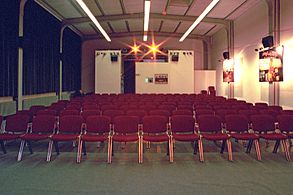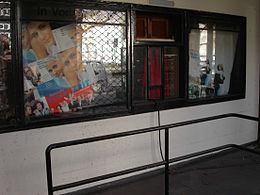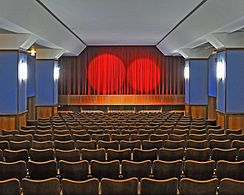Film studio Glückauf
The Glückauf film studio in Essen's Südviertel is one of the oldest cinemas in North Rhine-Westphalia . Opened in 1924, it was destroyed in 1945 and later rebuilt in the 1950s style. In 2001 it had to be closed because the cinema building had to be demolished in 2007 due to disrepair. Only the listed facade of the main building ( Glückaufhaus ) was preserved. The entire building complex was rebuilt and the reopening of the cinema was celebrated on December 18 and 19, 2009.
Furnishing
Until it was demolished in 2007, the cinema, covering an area of 600 square meters, comprised a 250-seat hall and a foyer bar, both in the style of the 1950s. Today the film studio fits the listed facade of the Glückaufhaus again . The 90 percent or so of the interior furnishings that could be secured were used again. Only the number of seats was reduced to 250 in order to achieve more legroom.
The film studio has received several awards for its annual programs, making it one of the most award-winning film theaters in Germany. Today it has a modern sound system with Dolby Surround , but also a Gulbransson cinema organ .
history
The film studio was opened on March 1, 1924. It was located in the Glückaufhaus, built in 1922/1923 based on a design by the architect Ernst Bode . During the Second World War , the film studio was destroyed by a bomb hit in 1945 and rebuilt two years later according to plans that have since disappeared. In 1953 a new facility, which is now a listed building, was installed. The Menz theater company took over the film studio in 1985. From 1991 until the lease expired in December 2002, Hanns-Peter Hüster ran it as a film art theater without subsidies. On April 19, 2001, the cinema had to be temporarily closed. The reason was deficiencies in the statics, which also had an impact on the ceiling construction.
In 2004 the real estate company Kölbl Kruse GmbH acquired the Glückaufhaus, which was previously owned by Ruhrkohle AG . The new owner of the property had informed the press that he was interested in keeping the cinema and its early reopening. The equipment was, also for reasons of monument protection, stored completely and carefully dismantled in order to avoid damage. A detailed documentation should ensure a faithful reconstruction.
On December 11, 2006, the association Rettet das Filmstudio e. V. founded on the initiative of the managing director of the Essen Lichtburg , Marianne Menze . With the benefit event Artists for the Film Studio on February 26, 2007 in Essen's Lichtburg, 240,000 euros were collected with the help of entrance fees and private donations. Here, among other things, offered Hagen Rether , Rafael Cortés , Rosa Montes and Alberto Alarcón and the trio of Essen Philharmonic and artists of the GOP vaudeville a surprise program by Manfred Breuckmann from WDR led.
In the meantime, the cinema program was relocated to the former switch hall (Hall 2) of the Zeche Zollverein until around the beginning of 2007 . Since the former building cube next to the Glückaufhaus was not worth renovating for structural reasons, it was demolished at the end of 2007.
Behind the listed facade of the Glückaufhaus, a new office building and the new film studio were built between 2007 and 2009. This makes it one of the oldest film theaters in Germany that is almost continuously operated as a cinema.
The renovation and reconstruction of the film studio cost almost 2.4 million euros. The owner of the Glückaufhaus, Kölbl Kruse GmbH , and the main tenant had each assumed 250,000 euros. The remaining amount of 1.8 million euros had to be financed through donations, there were no grants from the city. In February 2008, the reconstruction by private donors, and thus also the game operation, was secured for at least ten years. That was the demand of the state of North Rhine-Westphalia, otherwise it could have asked for its funding back. In the end, around 1,300 citizens had donated. Another 200 investors secured the operation of the cinema by buying fund shares . This safeguarded itself against reclaiming state funds in the event of a possible bankruptcy of the cinema.
The film studio reopened on December 18 and 19, 2009. The film Nanuk, the Eskimo by Robert J. Flaherty , which was shown when the cinema opened in 1924, was also shown.
Web links
Individual evidence
- Jump up, start the film. In: DerWesten.de. October 29, 2009, accessed July 6, 2015 .
- ↑ Description of the cinema in the program Filmspiegel of the Essen Film Art Theaters. (Page 31)
- ↑ Removed the facade - the new building becomes 'more original'. In: DerWesten.de. January 18, 2008, accessed July 7, 2015 .
- ↑ Cinema guarantors as screen heroes. In: DerWesten.de. February 29, 2008, accessed July 7, 2015 .
Coordinates: 51 ° 26 ′ 35.7 ″ N , 7 ° 0 ′ 24.7 ″ E







